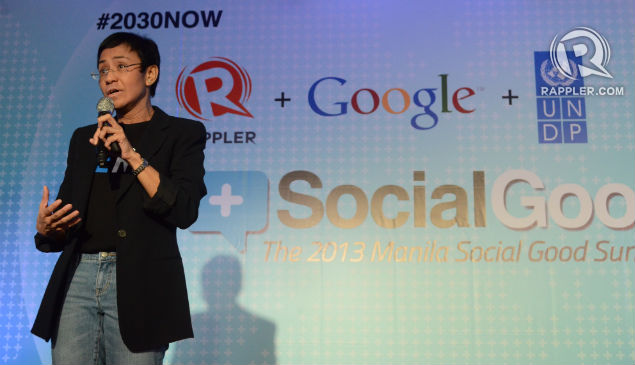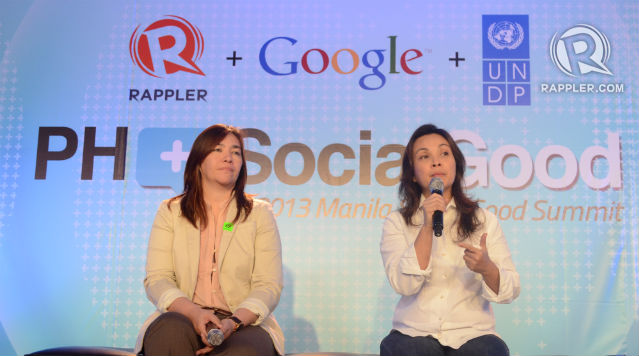SUMMARY
This is AI generated summarization, which may have errors. For context, always refer to the full article.

MANILA, Philippines – “Someday, we will come together to say we helped prevent the loss of life.”
This was how Rappler CEO Maria Ressa, visibly hopeful, opened the PH+SocialGood: The 2013 Manila Social Good Summit at the Asian Institute of Management in Makati City on Saturday, September 21.
Manila was the perfect venue for the 2013 Social Good Summit (SGS) – the city is the second most vulnerable to the disastrous effects of climate change, and we are seeing this fact unfold before our eyes each time a typhoon hits the country.
This year’s SGS focuses on how technology and social media – the “power of the many” – can help in mitigating the effects of climate change.
Framing the problem
United Nations Development Programme (UNDP) Country Director for Philippines Toshihiro Tanaka set the frame for the day’s discussions by showing the crowd how information sharing in different countries helped them through disasters.
The UNDP has piloted disaster preparedness programs in several barangays and cities in the country. With the help of local officials, it has helped capacitate communities to assess the local risks and find ways to reduce these risks.
Still, coordination among government agencies and with civil society can be further improved,
Patrick Meier of Digital Humanitarians joined the discussion from Qatar via Google Hangout.
He lauded how even before Typhoon Pablo ravaged the Philippines in 2012, government agencies, news organizations, and rescue groups were already promoting certain hashtags for Twitter to make information consolidation easier.
“People use social media to communicate during crisis,” Meier said. During such instances, social media posts spike up. During Japan’s nuclear disaster in 2011, there were 20,000 tweets sent per second.
Meier concluded that in this day and age, access to information has become as important as access to food and shelter. It has also become perishable, making accurate and real-time information on demand.
In 2008, Myanmar lost over 100,000 lives due to flooding brought by Cylone Nargis. Tanaka said during that time, there was information available to everyone as to what was happening all over the country, but the country fell short of sharing it to everyone. After all, information, when withheld, only benefits a few, he said.
When disaster hit the Philippines in 2012, information was shared in the country at a certain level. People knew the typhoon was coming and how strong it was going to be – fast. But where would they go for safety? Some schools and clinics being used as evacuation centers were also washed away.
Tanaka narrated how Japan faced a nuclear failure in 2011. He noted how his people, prepared and well-informed of the disaster, responded in a calm, educated way.
Can the Philippines attain that level of disaster preparedness?
“Some things cannot be done through shortcuts like climate change,” said Tanaka. He suggested that everyone must share responsibility and learn the causes and solutions to the problems.
There are threats that are predictable, he said, and even though most of them could not be stopped, there is always a way to mitigate its effects.
READ: #ProjectAgos: A call to action
How social media can help
Ressa elaborated on how mapping physical social networks helped in tracking down terrorists and how mapping can also help during crisis.
She said it took about a year to map out the physical social networks of terrorists but there is a way to do this in real time.
“What is Social Media? It’s your physical social network on steroids,” Ressa said. In times of crisis, the internet shows how people tend to form information hubs which vary in nature but all the same bring people together to discuss the issues and crisis.
READ: #ReliefPH: Help tropical storm ‘Maring’ victims
Ressa and Google product manager Andrew McGlinchey said that during times of disaster, internet presence, particularly on Twitter, and helping out in crisis mapping can go a long way.
Ressa gave examples of how certain political events – like The Million People March in August and the Corona impeachment trial in 2012 – were defined by the mood of people shared online.
“Neuroscientists say 80% of how we make decisions is based on how we feel, not how we think,” Ressa said.
However, Big Data has its inherent dangers, she said. There is, for example, the question of how one can keep his right to privacy in such circumstances and how algorithms are now deciding for us.
READ: #ThinkPH: Solving ‘wicked problems’ using the internet
The government’s take

Climate Change Commission Secretary Lucille Sering explained the dangers of climate change and how mitigating disasters become easier with knowledge.
She and her team were able to come up with a climate change map for Cagayan de Oro (CDO) after it was devastated by flashfloods brought by Typhoon Sendong in 2011.
READ: Climate Change Commission unveils first climate change map
The map shows a 3D version of CDO, factoring in climate change effects in the future. Knowing that such things may happen in the future can help reduce the loss of life during disasters, she said. “I didn’t want to scare you, but I wanted to show you that there is hope for this country.”
Known climate change prevention advocate Senator Loren Legarda, for her part, explained what the government is doing against climate change. They are doing their part through the legislation of laws that call for cleaner air, water, and the crafting of climate change prevention and disaster risk reduction policies.
However, the national government’s influence can only reach so far. “Kung sino ang mayor [sa isang lugar], sagot mo ang lugar mo (The mayor is responsible for his town),” Legarda said.
So far, only 25% of Local Government Units actually segregate their garbage. “Without a united front against climate change, we can do little to minimize the risks,” the senator said. – Rappler.com
Add a comment
How does this make you feel?
There are no comments yet. Add your comment to start the conversation.